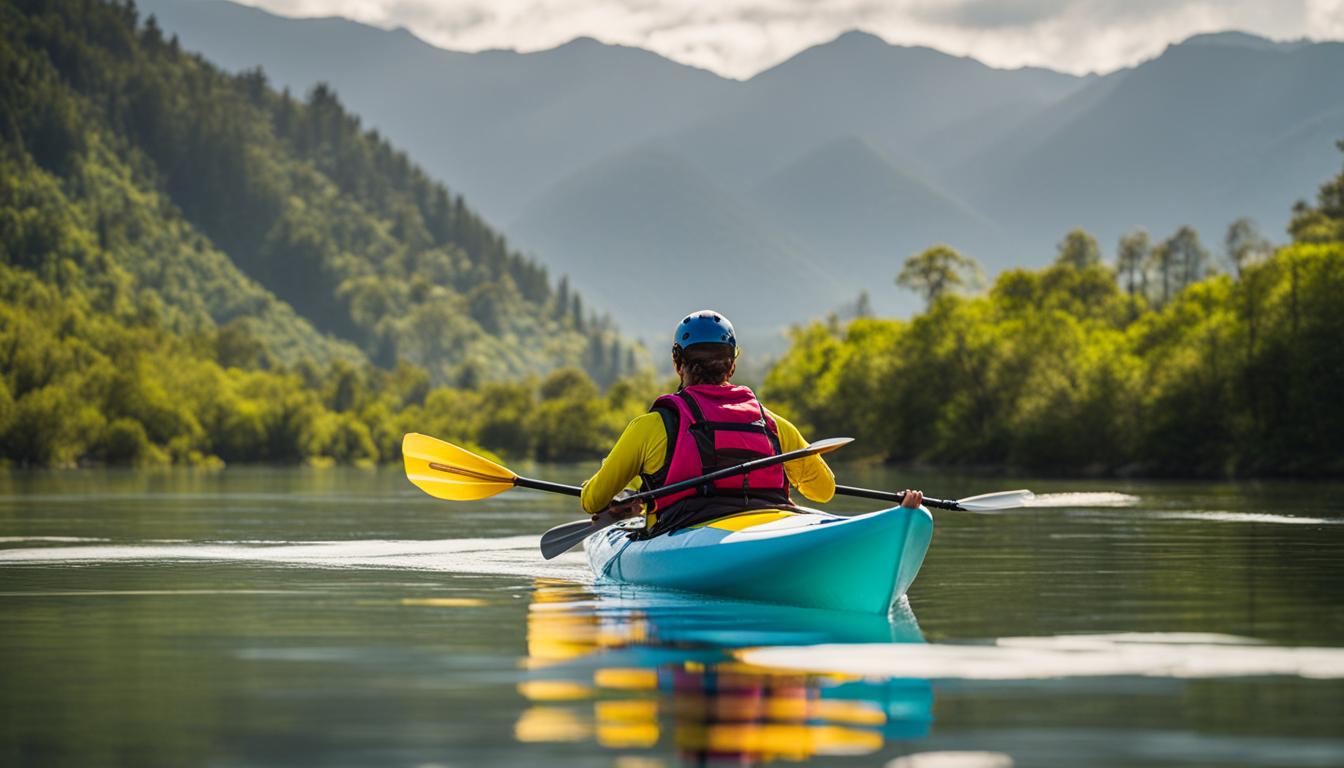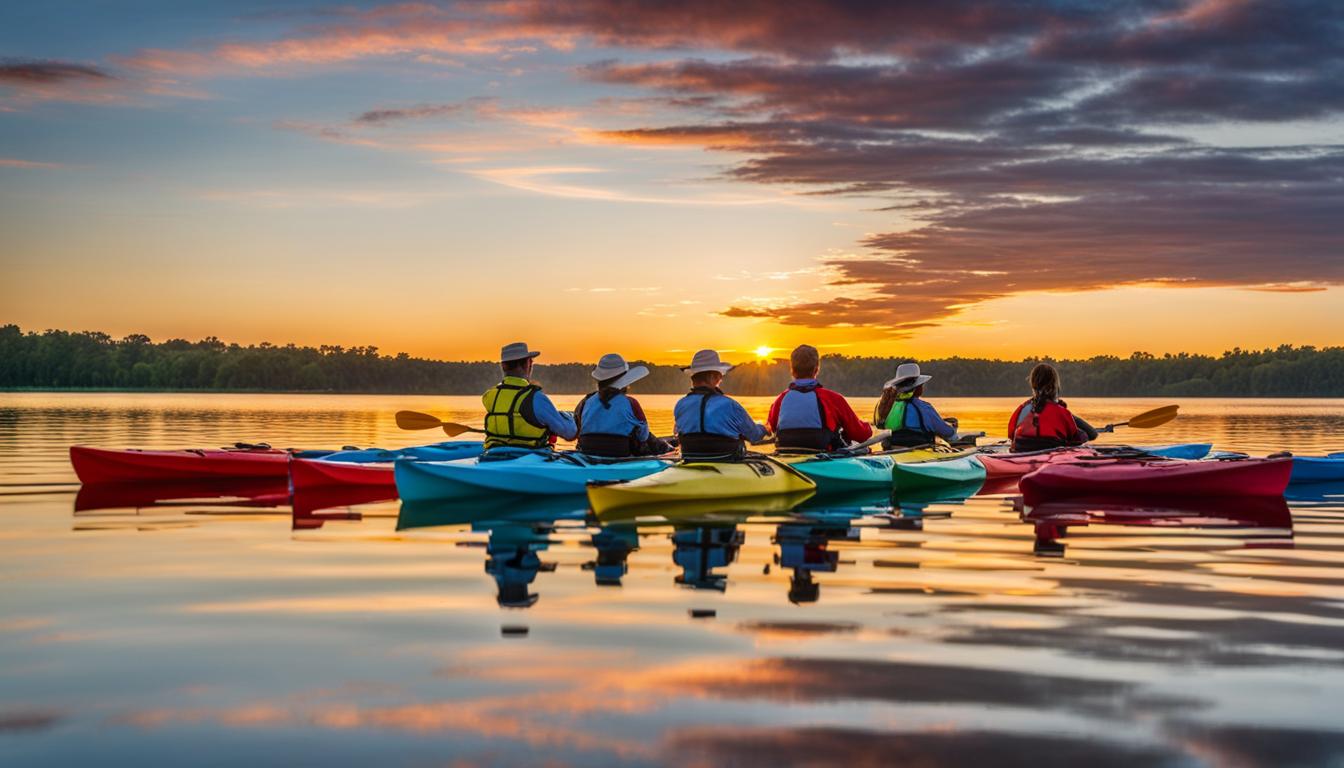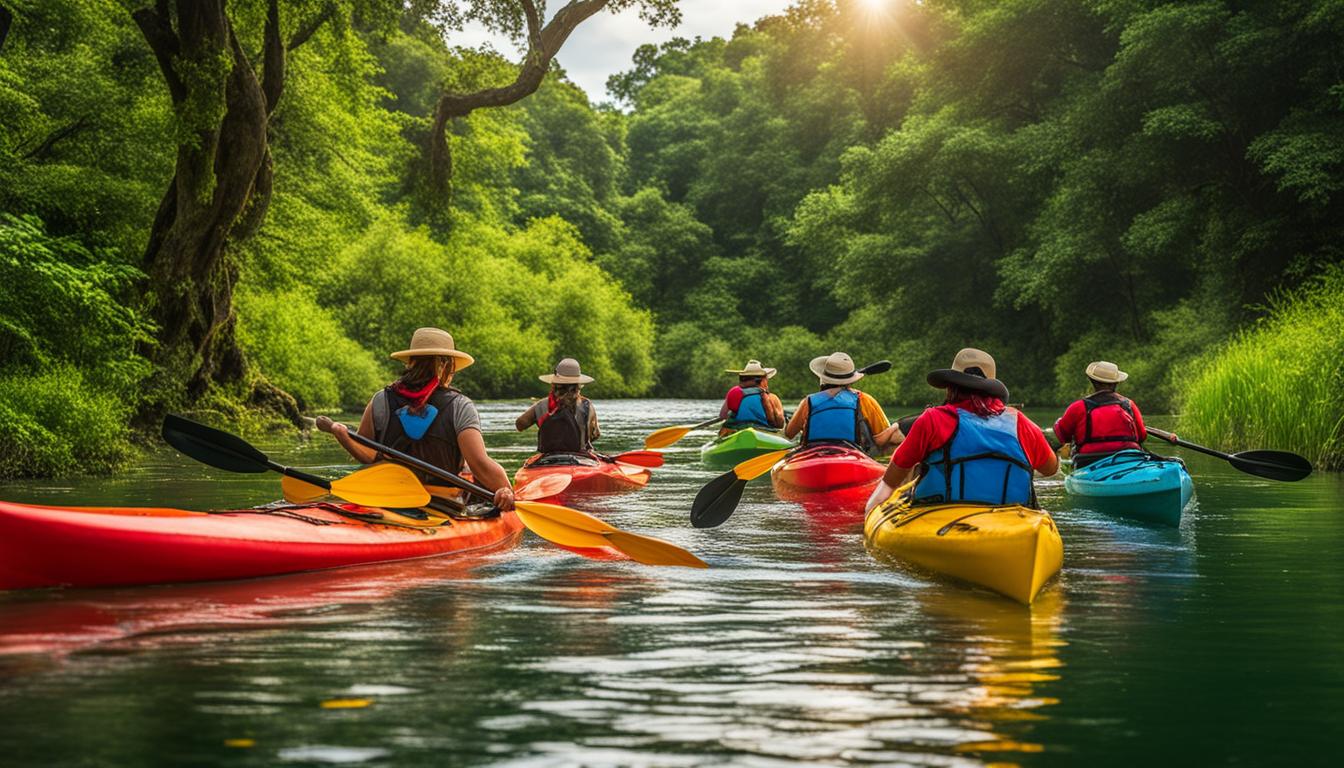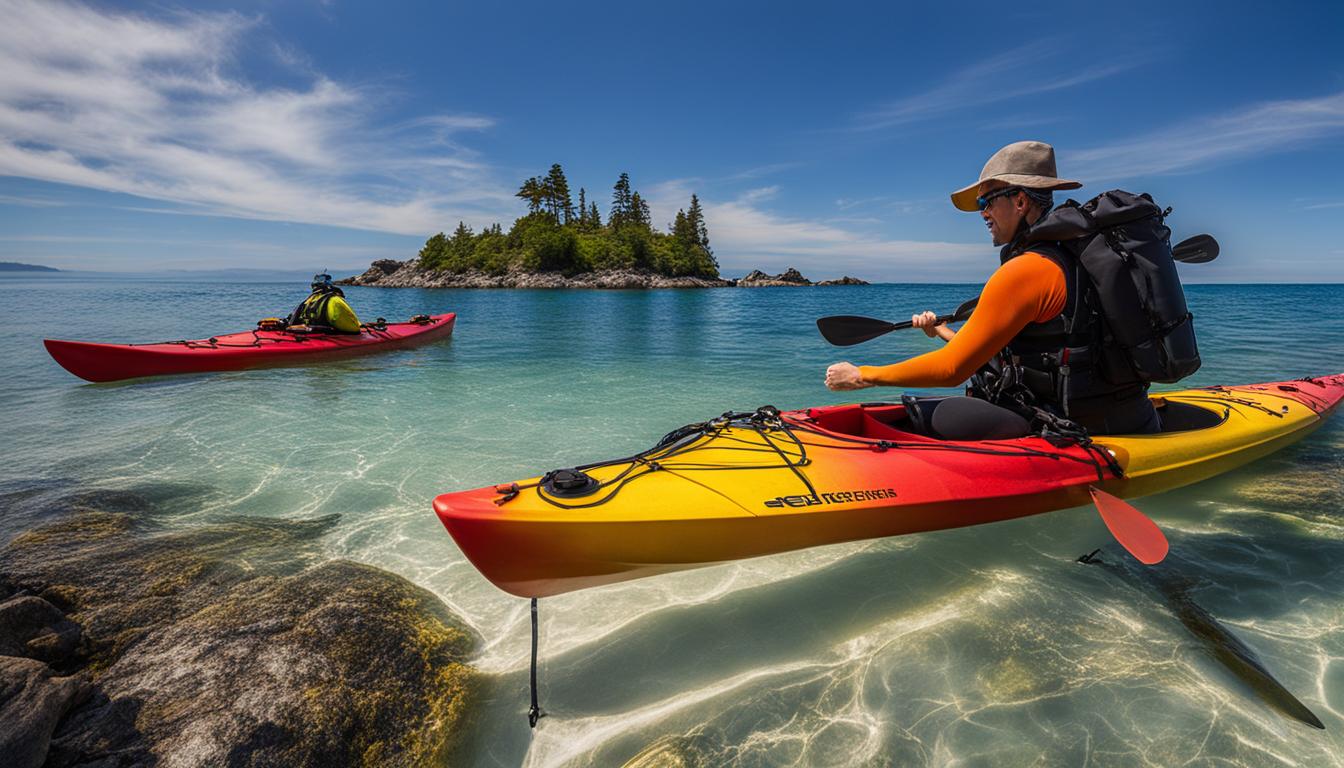Before diving into the exciting world of kayaking, it’s important to learn some basic skills. Whether you plan to rent a kayak or buy your own, developing these skills will help you navigate the waters confidently and safely. There are various ways to learn, from borrowing a kayak from a friend to signing up for a class or tour. Additionally, understanding essential gear and clothing, as well as how to adjust and launch your kayak, are crucial for a successful kayaking experience.
Key Takeaways:
- Learning basic kayaking skills is essential before renting a kayak.
- Consider borrowing a kayak from a friend or taking beginner kayak lessons.
- Understanding essential gear and clothing is crucial for a safe kayaking experience.
- Knowing how to adjust and launch your kayak properly is important for stability.
- Developing basic paddling techniques, such as holding the paddle correctly and mastering the basic strokes, will enhance your kayaking skills.
Essential Gear and Clothing for Kayaking
When preparing for a kayaking adventure, it’s important to have the right gear and clothing. Equipping yourself with the necessary items will not only enhance your safety but also ensure a comfortable experience on the water. Here are some essential items to consider before embarking on your kayaking journey:
- Coastguard-approved PFD: One of the most crucial pieces of gear you’ll need is a Personal Flotation Device (PFD). This is a life-saving device that should always be worn while kayaking, regardless of your swimming abilities. Choose a PFD that fits you properly and provides maximum buoyancy.
- Paddle: A properly-sized paddle is essential for efficient and effective kayaking. Consider the length of the paddle in relation to your height and the type of kayaking you plan to do. It’s also important to choose a paddle with comfortable hand grips and blades that are suited to your skill level and the water conditions you’ll be paddling in.
- Bilge pump: A bilge pump is a small handheld device used to remove water from the cockpit of your kayak. This is particularly useful if you encounter rough waters or heavy rain. Make sure to choose a pump that is lightweight and easy to use.
- Spray skirt: While not essential for all kayaking adventures, a spray skirt can be a valuable addition to your gear. It helps to keep water from entering the cockpit, keeping you and your belongings dry. Consider the type of kayaking you plan to do and the weather conditions you expect to encounter before deciding if a spray skirt is necessary.
In addition to the gear listed above, it’s important to dress appropriately for the weather and water conditions. In colder temperatures or rough waters, consider wearing a wetsuit or drysuit to keep yourself warm and protected. It’s also recommended to wear quick-drying and moisture-wicking clothing to ensure comfort throughout your kayaking journey.
Lastly, don’t forget to carry personal items such as water, snacks, sunscreen, and a first-aid kit. These items will ensure that you stay hydrated, nourished, and protected from the sun while enjoying your time on the water.
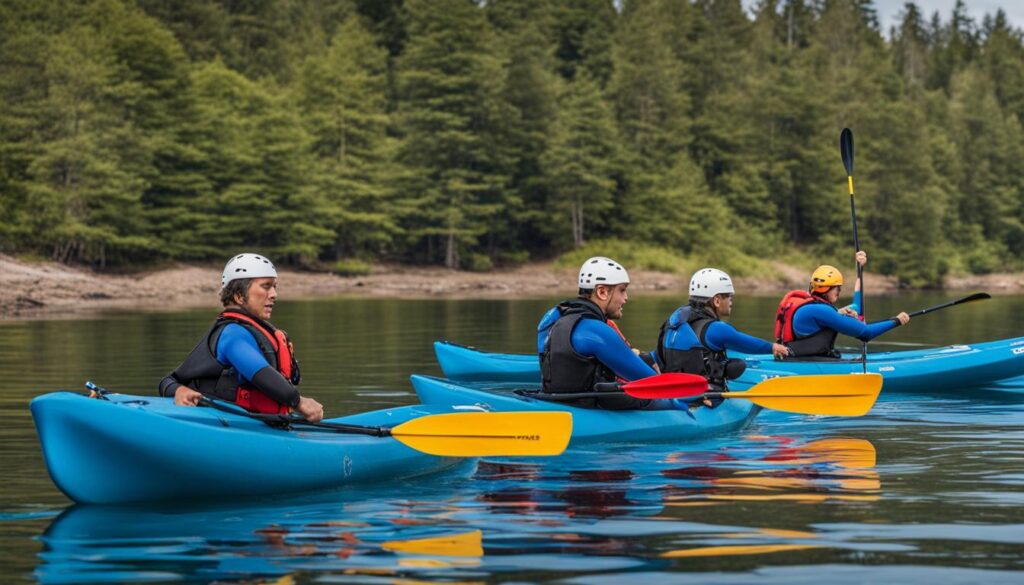
Table: Essential Gear and Clothing for Kayaking
| Item | Description |
|---|---|
| Coastguard-approved PFD | A life-saving device that should always be worn while kayaking |
| Paddle | Properly-sized paddle for efficient and effective kayaking |
| Bilge pump | A handheld device used to remove water from the cockpit |
| Spray skirt | Keeps water from entering the cockpit |
Adjusting and Launching Your Kayak
Properly adjusting your kayak before launching is key to stability and comfort while paddling. To ensure a successful launch, follow these essential steps:
Anchoring Yourself in the Kayak
When getting settled into your kayak, start by adjusting the seat backrest to a comfortable position. It should provide enough support for your lower back while allowing you to twist your torso for paddling. Position your feet on the footpegs and ensure they are firmly planted. This will give you better control and stability while maneuvering. Lastly, press your knees against the sides of the cockpit to establish a solid connection with the kayak.
Choosing the Right Launch Point
When launching your kayak, it’s important to find an appropriate spot. Look for gradually sloping shorelines or designated kayak launch areas. Avoid dragging the hull of the kayak on any surfaces, especially rocks or cement, as this can damage the kayak. If possible, have a friend assist you by steadying the kayak and providing an extra set of hands.
Entering and Exiting Your Kayak
When entering the kayak, place your paddle across the cockpit in front of you for stability. Lower yourself into the seat, keeping your weight centered and your balance steady. Once seated, place one leg at a time into the cockpit, followed by your feet onto the footpegs. To exit the kayak, reverse the process, carefully lifting one leg at a time out of the cockpit and using your paddle for support.
By following these steps, you’ll be well-prepared to adjust and launch your kayak confidently. Remember to always prioritize safety and be aware of your surroundings while on the water.
| Common Mistakes | Proper Techniques |
|---|---|
| Leaning too far back in the seat | Adjust the seat backrest to a comfortable position that supports your lower back while allowing torso rotation. |
| Not positioning feet securely on the footpegs | Place your feet firmly on the footpegs to enhance control and stability. |
| Dragging the kayak across rocks or cement | Find a suitable launch point with gradually sloping shorelines and avoid damaging the hull. |
| Entering or exiting the kayak awkwardly | Use your paddle for stability and carefully lower yourself into or out of the cockpit. |
Basic Paddling Techniques for Kayakers
Mastering the basic paddling techniques is crucial for a smooth and enjoyable kayaking experience. Whether you are a beginner or looking to refine your skills, understanding the proper techniques will enhance your efficiency and control on the water. Here are some key techniques to help you paddle like a pro:
- Forward Stroke: The forward stroke is the foundation of kayaking, propelling you forward. To execute this stroke, start by twisting your torso, reaching your paddle forward, and immersing the blade in the water near your feet. As you pull the paddle back, rotate your torso and repeat the motion on the other side. The forward stroke provides you with the power you need to move efficiently through the water.
- Reverse Stroke: The reverse stroke is used for slowing down or moving in reverse. It is essentially the opposite of the forward stroke. Start by immersing the blade near your hips and push the paddle away from your body. Rotate your torso in the opposite direction from the forward stroke while maintaining a firm grip on the paddle. The reverse stroke allows you to navigate in tight spaces or make quick adjustments on the water.
- Sweep Stroke: The sweep stroke is used for turning the kayak. To execute this stroke, start by immersing the blade near your toes and sweep it in an arc away from the kayak. Rotate your torso in the direction you want to turn, keeping the paddle close to the water’s surface. The sweep stroke allows you to make sharp turns and maneuver around obstacles.
By practicing these basic paddling techniques, you will gain confidence and control over your kayak. Remember to maintain proper posture, engage your core muscles, and maintain a relaxed grip on the paddle. With time and practice, these techniques will become second nature, allowing you to enjoy the beauty of the water while gliding effortlessly through it.
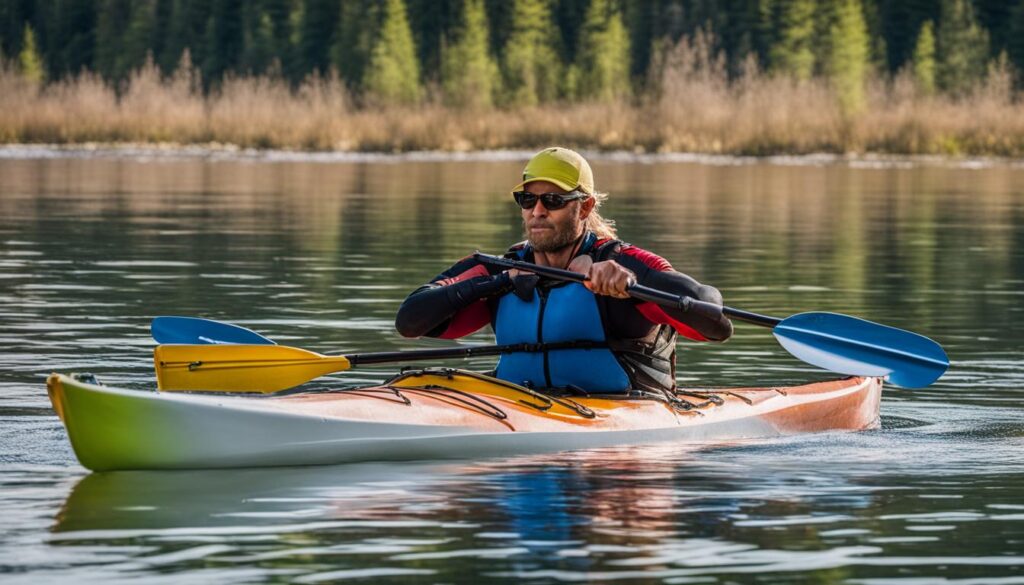
Tips for Perfecting Your Paddling Technique:
- Keep your paddle close to the kayak’s hull to maximize efficiency and reduce strain on your arms.
- Engage your core muscles and focus on rotating your torso rather than relying solely on your arms.
- Practice paddling on calm waters before tackling more challenging conditions.
- Experiment with different paddle angles and grips to find what feels most comfortable and effective for you.
- Take breaks and rest if you feel fatigued to avoid strain or injury.
“Paddling is not just about strength; it’s about technique. Focus on mastering the proper form, and you’ll find that you can paddle longer and more efficiently without tiring yourself out.” – Kayaking enthusiast
| Benefits of Proper Paddling Technique | Consequences of Poor Paddling Technique |
|---|---|
|
|
Remember, paddling is not just about power but also about technique. Focus on mastering the proper form, and you’ll find that you can paddle longer and more efficiently without tiring yourself out. Practice regularly, seek guidance from experienced kayakers, and enjoy the journey of improving your paddling skills.
The Basic Kayaking Strokes
Mastering the basic kayaking strokes is essential for efficient and controlled paddling. These fundamental techniques will allow you to navigate the waters with confidence and precision.
Forward Stroke
The forward stroke is the most commonly used stroke in kayaking. It involves a combination of torso rotation and paddle positioning to propel the kayak forward. To execute the forward stroke, wind your torso and immerse the blade near your feet, then rotate your torso as the blade moves behind you. This movement generates power and propels the kayak in a straight line. Repeat this stroke on both sides of the kayak to maintain balance and efficiency.
Reverse Stroke
The reverse stroke is the opposite of the forward stroke and is used for slowing down or moving in reverse. To perform the reverse stroke, twist your torso in the opposite direction while immersing the blade behind you. This stroke is particularly useful when you need to make slight adjustments or navigate in tight spaces. By mastering the reverse stroke, you will have greater control over your kayak’s movement.
Sweep Stroke
The sweep stroke is used for turning the kayak. It involves carving a wider arc on one side of the boat. To execute the sweep stroke, start with your paddle positioned parallel to the kayak’s side. Immerse the blade near your feet and sweep it outward in a wide arc, creating a turning effect. This stroke is especially useful when navigating around obstacles or changing direction. By practicing the sweep stroke, you can maneuver your kayak with agility and precision.
Bracing Stroke
The bracing stroke is a defensive stroke used to stabilize the kayak and prevent capsizing. It involves using the paddle to support your weight and maintain balance. To perform the bracing stroke, extend your arm and place the paddle blade flat on the water’s surface. Apply slight pressure, using the paddle as a brace to counteract the force of waves or strong currents. This stroke is essential for maintaining stability in challenging conditions.
By mastering these basic kayaking strokes through beginner kayak lessons or self-guided practice, you will develop the foundation for more advanced paddling techniques. Remember to practice in calm waters with proper safety precautions, and always wear a personal flotation device (PFD) for your safety. So grab your paddle, hit the water, and enjoy the exhilarating experience of kayaking!
Conclusion
Learning and developing basic kayaking skills before renting a kayak is essential for beginners. By understanding essential gear and clothing, adjusting and launching your kayak properly, holding your paddle correctly, and mastering the basic kayaking strokes, you will be well-prepared for your kayaking adventure.
For those looking to enhance their skills, pre-rental kayak training courses provide a comprehensive introduction to kayaking. These courses cover everything from safety techniques to paddling basics, ensuring you have the knowledge and confidence to navigate the waters with ease.
Whether you choose to take a class, go on a guided tour, or learn from a friend, investing time in developing these skills will enhance your overall kayaking experience. So, if you’re ready to embark on your kayaking journey, remember to start with the basics and gain the confidence needed to explore the beauty of the waterways.
So, grab a paddle and get ready for an exciting adventure on the water. With the right skills and knowledge, you’ll be able to fully enjoy the wonders of kayaking and create unforgettable memories. Happy paddling!
FAQ
How do I learn basic kayaking skills before renting a kayak?
There are various ways to learn, from taking classes or tours to borrowing a kayak from a friend. Investing time in developing these skills will enhance your kayaking experience.
What gear and clothing do I need for kayaking?
You will need a Coastguard-approved PFD, a properly-sized paddle, a bilge pump, and optional gear like a spray skirt. Dress appropriately for the weather and water conditions, and carry personal items such as water, snacks, sunscreen, and a first-aid kit.
How do I adjust and launch my kayak?
Ensure a snug fit in your kayak by positioning yourself against the seatback, placing your feet on the footpegs, and keeping your knees in contact with each side of the cockpit. When launching, avoid dragging the hull on surfaces, choose gradually sloping shorelines, and consider having a friend assist you.
How do I hold my kayak paddle correctly?
Center the paddle shaft on top of your head, grasp it with both hands, and align the blades. Place your large knuckles on top of the shaft with a relaxed grip. Holding the paddle correctly will help you execute basic kayaking strokes with ease.
What are the basic kayaking strokes?
The forward stroke is used for moving forward, involving torso rotation and blade immersion near your feet. The reverse stroke slows down or moves you in reverse. The sweep stroke turns the kayak by carving a wider arc on one side.
Why is learning basic kayaking skills important before renting a kayak?
Learning these skills ensures you can navigate the waters confidently and safely. It also enhances your overall kayaking experience, allowing you to enjoy the beauty of waterways with confidence.

